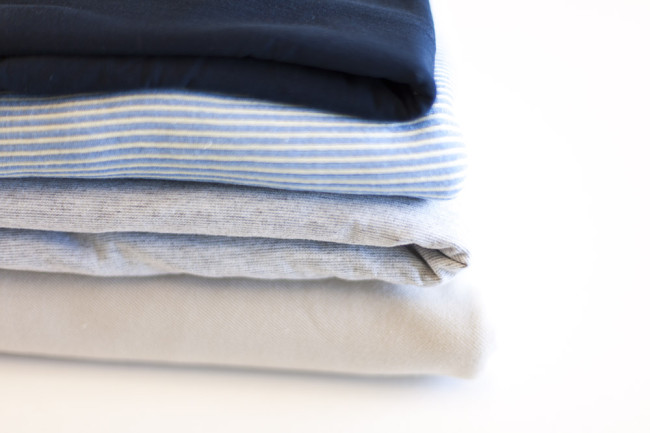
To begin our sewalong, we’ll be giving you a couple weeks to begin picking out your fabric and gathering your supplies.
Gather your supplies
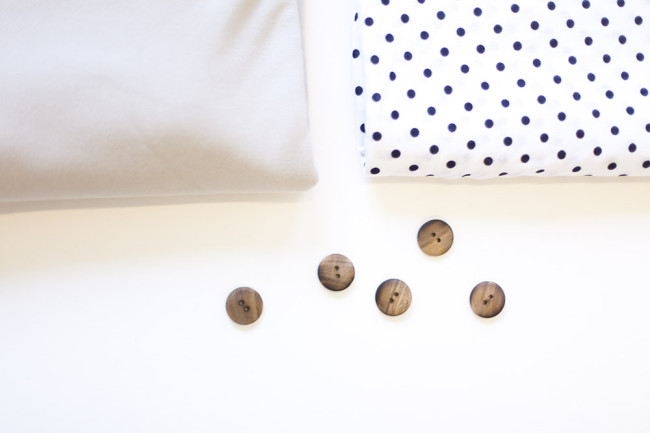
Here’s what you’ll need to make the Mabel skirt:
- Main Fabric. Look for a firm, stable knit such as ponte or double knit. See the section fabric section below for a little more guidance on these fabrics.
- Lining Fabric. Your lining fabric will be used to line the inner waistband. Use a thinner fabric for this to keep the waistband from getting too bulky. Look for a medium- or lightweight jersey for this.
- Five 1-inch buttons (version 2). These buttons will go down the front of your skirt if you’re making version 2.
Choosing your fabric
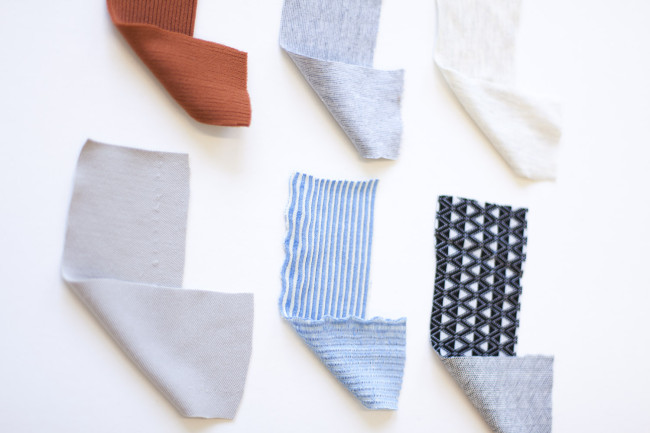
Your main fabric for this skirt should feel thick and stable. This will help smooth your skirt over lumps and bumps, reduce the hazards of visible panty lines, help the skirt retain its shape, and give the skirt a dressier look.
Ponte or double knit (which are slightly different but often labeled interchangeably) are both excellent choices.
Sometimes, you can find stable, firm rib knits that work well. Rib knits tend to be quite stretchy, but can also be thick and hold their shape well. There is a huge variety in rib knits, so be careful to choose one with some weight and thickness.
Heavy, thick jersey or interlock jersey can also be a good choice. Again, look for something that feels sturdy and isn’t too thin.
French terry is a sturdy fabric with a looped back that can also work and feels good next to the skin. It’s an easy fabric to work with and very versatile.
For the waistband lining, a medium- or lightweight jersey is the best choice because it won’t add much bulk around your waist. Find a jersey that’s light, but not so light that it’s transparent.
Cute options online
Here are a few adorable thicker knits I’ve found online. So cute! I can’t vouch for the suitability of all of these because I haven’t bought them myself, but these are items in the right category of knits and could work well.
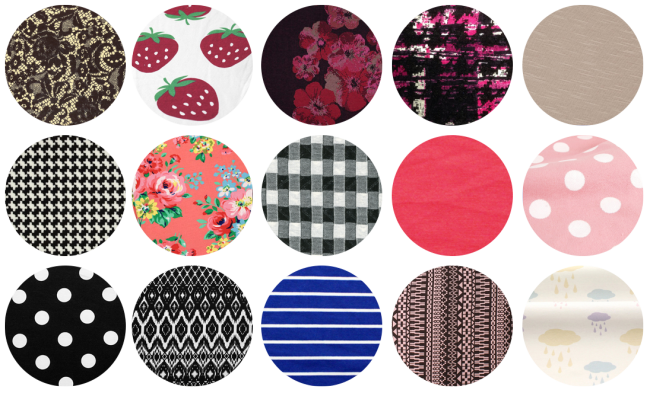
Row 1:
Lace print ponte from Hart’s
Strawberry French terry from Bonita fabrics
Floral ponte from Mood
Funky houndstooth ponte from Grey’s Fabrics
Slub ponte from fabric.com
Row 2:
Marni double knit houndstooth from fabric.com
Floral French baby terry from Bonita Fabrics
Double knit checks from Hart’s Fabric
Coral ponte from Girl Charlee
Pink dot French terry from Bonita Fabric
Row 3:
Black and white dot ponte from Girl Charlee
Ikat ponte from Girl Charlee
Blue stripe ponte from Girl Charlee
Pink and black rib knit from Bonita Fabric
Cloud interlock knit from Bonita Fabric
Gather your tools
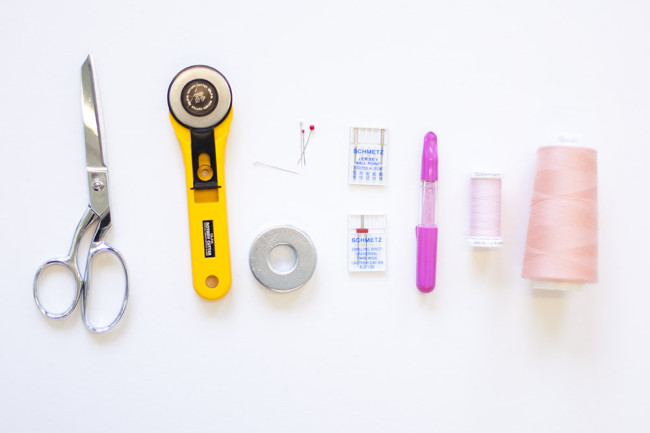
- Sewing Shears. Use sewing shears (also called dressmaker’s shears) to cut your fabric. Even if you use a rotary cutter, it’s a good idea to have these on hand.
- Rotary cutter (optional). Not necessary, but makes cutting your fabric go faster. If you go this route, you’ll also need a mat.
- Pins. You’ll need plenty of pins. I prefer glass head ones because they won’t melt under your iron.
-
Pattern weights. Use these to hold the pattern on your fabric while you trace it, or while cutting with a rotary cutter.
Hand sewing needles. You’ll be doing plenty of hand stitching, so grab some of these. - Marking pens or chalk. Choose one that stays put and shows up easily on your fabric, but washes away cleanly.
- All purpose thread. If you’re using a serger, purchase thread on cones. Otherwise, all purpose polyester thread on spools will do.
- Ballpoint needles. Ballpoint needles (sometimes labeled as “jersey needles”) are ideal for sewing knits. They separate threads in the fabric rather than piercing them, reducing the chance of runs.
- Twin needle. A twin needle can be used to sew a neat and stretchy hem on a standard sewing machine. Look for the wide twin needle, which is 1/4 inch in width.
Equipment
You can make this skirt with either a serger or a standard home sewing machine. We’ll talk in more detail about both options in a future post.
If you’re using a serger, you’ll still want a standard machine on hand for hemming and a few other small tasks.
Pretreat your fabric
Before we start sewing, pretreat your fabric by washing and drying it the same way you plan to treat your finished skirt. This will emiminate shrinkage before you start cutting.
Do you have any questions about fabric, tools, or supplies? Let me know in the comments!



Comments
A question about fabric choices — I am hoping to make something that is not too clingy for work (a little self conscious). Stretch seems to vary among the fabric choices. Does more stretch (like 50%) mean that I’m more likely to avoid the va-voom factor?
Not necessarily. Some fabrics with a lot of stretch will be very clingy, particularly if the skirt is cut a little snug.
I would choose a thick fabric like a ponte for modesty, and if you don’t want it to cling around your bottom, try tapering the side seams out to a larger size at the hem. This will give the skirt a little more flare and make it less clingy through the hips and butt, but still snug at the waist.
Glad I asked — thanks!
Thank you for asking Alison. It was worrying me so much that I was reluctant to try the pattern. I like the fit of Sarai’s version in her mbm photo.
You mention fabric but I don’t see any mention of muslin in this post. Am I to assume that because we are using knit fabric, we can forgo the typical muslin making stage. I’d like to order some fabric online, but it’s hard to find a matching muslin fabric as I am a fabric novice.
Muslins/test garments are not quite as useful for knit garments, unless you make them out of the same fabric. That’s because the type of fabric will influence the fit so much.
The best thing to do is to adjust the garment as you sew. Try it on at different stages to see how things are fitting, and make adjustments from there.
Alternately, you can buy extra fabric and make one practice garment with it.
Hello Sarai,
You are either going to say no or Yes, but I can ask.
I must travel on June 2nd till the 9th. My 9 months, pregnant daughter needs my help that week.
would it make sense, or should you send me the information earlier? I have my fabric, washed and ready.
warmly,
Marion
It shouldn’t be a problem, Marion. All the information will still be here when you get back, so you can follow the lessons at your own pace.
Help us out, Sarai, so far you have not mentioned the yardage we need. The pattern is at home; I’m at the fabric store. Eek
Here’s a link to the yardage chart on our website: https://static.colettepatterns.com/assets/shop/1029/1029-measurements-6d76d3b223ca7ae00906d2bee3282726.png
It depends on your size and the fabric width, but generally you need between 1 and 1 1/2 yards.
Sarai,
I have a purple supplex that’t been sitting in my stash for a long long time. I have been planning to try my first Mabel using it, but I just realized it will probably not have enough structure. am I right?
I should get something “sturdier”, shouldn’t I?
I am repeating myself, but oooh I am so happy with this sewalong!!
Thank you,
loads of love *
I actually just realized, supplex is a fiber, not a type of knit.
Hmmm, I really am doubtful. This knit is really soft to touch, and really pleasant, but I am not sure it is “thick” enough.
Do you have any suggestions for me, meaning, so I can be sure?
I know it’s a difficult question.
thanks again!
I think most supplex fabrics are likely be a little light. I really like ponte or double knit best!
However, I have seen some people make it in lighter fabrics. It has a different look to it, but can still work. It’s a little more casual.
Thanks for a quick reply!
It’s somewhat hard to translate these things.
plus, in fabric shops in Brazil people don’t really know the right names and terms for their product. I wish I could find ways to tell you, but a quick example is when I came to a shop that only sells knits, and they told me they didn’t work with knits. I asked “what do you mean?” – they use the term knit (malha, in portuguese) to refer to cotton knits. The rest is lycra, supplex, rib knit at most(because it’s really different!).
I thought about this when reading the book, it would be amazing to have a reference like a small display case(I am not sure this is the term), with small samples(a 2″ square) of fabric. I know it is impractical, but it would solve issues like this, for non-english-speaking countries.
just and idea, don’t misunderstand me, I LURVE the book.
will find a more appropriate fabric!
Hello Juliana,
I am also sewing from Brazil, where are you based? It´s hard to find people here to discuss sewing stuff, would you like to keep in touch? my email is tatimaio@yahoo.com.br
See you soon!
Tatiana
Oh super excitement! I just got a serger recently and have been keen to learn knit fabrics.
Do you think this pattern would be suitable for pregnancy? I’m fast growing out of clothes and keen to make some items that are comfy. Do you think this pattern would be easy to alter?
It’s a really simple shape, so I do think it will be easy to alter! I’m not an expert in maternity alterations, but with the stretch of the waistband, I could see this holding up pretty well!
What I’d do is cut it a bit longer, then try it on and even out the hem from there. You’ll likely want a bit more length in the front than normal to cover the expanding tummy.
I saw a great stretch twill that I am considering. Would you think that is too stiff to be suitable?
The skirt is really designed for knits rather than wovens with lycra. It might not stretch enough to wear comfortably.
However, I will say that one of our test sewers on this pattern did use a stretch woven by mistake, and it ended up working! It’s something you’d have to experiment with, but the results aren’t really guaranteed I’m afraid.
Thanks! There were so many options at the store, but I picked up some knit options at the same time. If all goes well, I can make both. :)
How much fabric is required for a knee lenght skirt?
Your pattern will have all the yardage measurements for each size.
Or the requirements are here under the “supplies” tab: https://www.colettepatterns.com/sewing/mabel
Hi!
I’ve been reading the wardrobe architect since the begining, but only recently started to actually DO the assignments. Living on the other hemisphere kinda changes things a bit: due to the opposite seasons, when the project started we were in the middle of the summer (i.e. vacation, lots of outdoor time, no plans at all) so I delayed it a few months in order to be able to put my whole attention into it.
We’ve one month left of autumn in Buenos Aires and I’m finally putting it all together and building a new, much better wardrobe where Mabel and Moneta play a big role. So I am really happy for this (my first!) sewalong as it is giving me the opportunity to go past my fear and start working with knits.
I’ll be buying a few different fabrics next week and I’m looking forward to start making a bunch of this simple comfy skirts. Thank you in advance for all the tips!
Love, Ro
P.S. I have entered my email to join the sewalong (and comfirmed it right away) but haven’t received this update. Will I be getting the next posts or should I submit it again? Thanks!
I take it back, the email just came in! :)
Welcome!
Good morning, did I miss what pattern we are using? Could you send it out again. I am looking forward to making something for myself.
The pattern is the Colette Patterns Mabel: https://www.colettepatterns.com/sewing/mabel
i just bought a few possible fabrics from fabric.com. so excited to try this sewalong! i’m a pretty novice sewist, but i would really like to learn to work with knits without fear. i have a brother 1034d serger and am wondering whether i need any special needles for that or whether the ballpoint and twin needles are just for my regular machine. (and do i still need those if i plan to use the serger for everything possible?) thanks!
The twin needle is for your standard sewing machine in order to create the hem. That may be the only thing you need the standard sewing machine for if you are using the serger as much as possible.
The ballpoint needles would be for either the serger or the standard machine. If you buy a packet of them, you can use them in both.
Oops, posted this under the welcome comments… so this is a little bit of a duplicate…
I’m delighted to see the funky pink-black houndstooth from Gray’s fabric suggested. I bought some of it for the first mabel I made and it looks super. It was very easy to work with, feels weighty without being heavy. It’s a really nice fabric. I’m tempted to buy more of it and make a smaller size since I should have made a medium instead of a large. (I love the skirt and fabric soo much, it’s hard to resist this temptation.) But I also have some classy looking navy double knit that I plan to use for this sew-a-long.
I’m glad to hear the feedback on that particular fabric. Good to know!
Not too many comments, but super excited that this sew-along has finally started. Oh, and I love, love, love the ponte knit you mention above from fabric.com. I like the neutral color and I may order that one. But what about the lining? Hmm, have to read the rest I suppose and stop thinking out loud (or in writing)! Thank you so very much Sarai, Annette
Any light or medium jersey should work for the waistband lining!
Does the twin needle have to be a ballpoint? I don’t remember seeing that option where I bought mine…
You know, I don’t think I’ve seen ballpoint twin needles either. Does anyone know if they exist?
I’ve always used a regular twin needle with no ill effects. If you think about it, there’s less stress on the hem (where you’re using the twin needle) than seams. Whenever I’ve had trouble with knit fabrics running, it’s always been at stressed seams.
My twin needle is ballpoint (or it might say jersey). Both “universal” and ballpoint were options at my local fabric store. It also occurred to me that the twin needles will wear out and need to be replaced just like regular needles, so I might buy a few next time I’m at the store.
Thanks!
Hi Sarai, I actually found a Bernina twin needle that says “stretch” on the packaging (got it for 30% off during a recent sale) which I’m assuming is for knits. I’ve never used a twin needle before so I don’t have anything to compare it to, but the store employee said it would work for your knit patterns.
Linked up your sew along here, hope some new folks click over and join in! http://swoodsonsays.com/sew-a-long-calendar/
I found some ballpoint twin needles on amazon! There are also stretch needles, which I think are for stretch stich settings?
http://www.amazon.com/Schmetz-Twin-Assortment-Needles-Sz1-6/dp/B003IPJNES/ref=sr_1_4?ie=UTF8&qid=1400892999&sr=8-4&keywords=twin+ballpoint+needle
Looking forward to this… I haven’t done any garment sewing since last summer. Am planning to buy woven fabric to make a Sorbetto top to go with my version 3 Mabel skirt.
I am mature and feel that the skirt is too short. I usually wear skirts at or below the knee. How easy is it to lengthen, or should I sew along with a different pattern
Susan, version 3 is just above the knee. But you can lengthen it to at or below the knee.
Do you know percent stretch the pattern is designed for? I have two ponte knits to choose from. One has hardly any stretch and the other is nearly 50%.
We recommend a minimum of 10% stretch. Anything over that should be fine, as long as your fabric has good recovery.